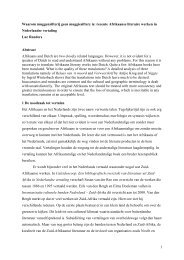View/Open - Document Server@UHasselt
View/Open - Document Server@UHasselt
View/Open - Document Server@UHasselt
Create successful ePaper yourself
Turn your PDF publications into a flip-book with our unique Google optimized e-Paper software.
Abstract<br />
The effects of orthognathic surgery in three dimensions – 3D cephalometry<br />
Aims Orthognathic surgery is an effective method for correcting significant skeletal and dentofacial<br />
discrepancies. Surgery of craniofacial deformities is a complex task that requires careful<br />
preoperative planning. While treatment must affect all three dimensions, many of the current tools<br />
of diagnosis utilize only a two-dimensional representation of the patient. The development of a new<br />
innovative technique like 3-dimensional cephalometry, based on multi-slice CT images could<br />
improve the specification of the craniofacial skeleton, treatment planning and evaluation of the<br />
result.<br />
Is it possible to find significant landmark measurements that are useful during diagnosis? Is there a<br />
constant relation between the diagnosis-significant landmarks of hard and soft tissue? How does<br />
surgery influence these landmarks?<br />
Methods From a single multi-slice CT data-set virtual lateral and frontal cephalograms are<br />
computed and linked with both hard and soft tissue 3-D surface representations. To start the<br />
analysis, the segmented hard and soft tissue representations are rendered in a virtual scene. This<br />
innovative 3-D virtual scene approach allows accurate and reliable definition of Nasion and Sella,<br />
the set-up of an anatomic Cartesian 3-D cephalometric reference system, definition of 3-D<br />
cephalometric hard and soft tissue landmarks, the set-up of 3-D cephalometric planes and 3-D<br />
cephalometric hard and soft tissue analysis.<br />
Results Using the 3-D approach the definition of hard and soft tissue landmarks is accurate and<br />
reliable. A general trend is found in the landmarks of hard and soft tissue. These landmarks are<br />
meaningful in the diagnosis of orthognathic surgery. The influence of surgery on the landmarks is<br />
dependent on the type of surgery.<br />
Conclusion Three-dimensional cephalometry based on multi-slice CT images provides a better<br />
insight into specification of the craniofacial skeleton and relation to soft tissue, treatment planning<br />
and evaluation of the results.









